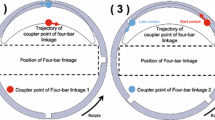Abstract
An Automatic tool changer (ATC) is a device used in a tapping machine to reduce process time. This paper presents the optimization of a Peak torque reduction mechanism (PTRM) for an ATC. It is necessary to reduce the fatigue load and energy consumed, which is related to the peak torque. The PTRM uses a torsion spring to reduce the peak torque and was applied to a novel ATC mechanism, which was modeled using inverse dynamics. Optimization of the PTRM is required to minimize the peak torque. The design parameters are the initial angle and stiffness of the torsion spring, and the objective function is the peak torque of the input link. The torque was simulated, and the peak torque was decreased by 10 %. The energy consumed was reduced by the optimization.
Similar content being viewed by others
References
L. Zhang, C. He and G. Chen, Application of tool compensation in CNC machining, Materials Science Forum, 800–801 (2014) 435–439.
Y. Yan, Y. Yin, Z. Xiong and L. Wu, The simulation and optimization of chain tool magazine automatic tool change process, Advanced Materials Research, 834–836 (2013) 1758–1761.
X. H. Lu, P. Z. Han and W. Y. Wu, Reliability evaluation of chaisn-type tool magazine and ATC, Applied Mechanics and Materials, 271-272 (2012) 461–465.
F. Y. Li, Q. Wang, X. J. Wang and Y. X. Peng, Research on RFID technology in tool changing of the NC system, Advanced Materials Research, 694–697 (2013) 1873–1876.
M. B. Vaghela, V. J. Savsani and S. B. Jadeja, Design and kinematic analysis of an automatic tool changing mechanism used in VMC, Proc. of International Conference on Advances in Tribology and Engineering Systems, India(2013) 269–283.
DMG Mori Seiki, http://en.dmgmori.com/products/millingmachines/highly-productive-compact-machining-centres/milltap/milltap-700 (retrieved at 06/10/16).
FANUC, http://www.fanuc.co.jp/en/product/robodrill/index. html (retrieved at 06/10/16).
J.-W. Kim, J. Kim and T. Seo, New angular transmission design based on a four-bar linkage mechanism, Proc. of ASME 2015 International Design Engineering Technical Conferences and Computers and Information in Engineering Conference, USA(2015).
C. Sun, W. L. Xu, J. E. Bronlund and M. Morgenstern, Dynamics and compliance control of a linkage robot for food chewing, IEEE Transactions on Industrial Electronics, 61 (1) (2014) 377–386.
R. F. Fung, C. L. Chiang and S. J. Chen, Dynamic modelling of an intermittent slider–crank mechanism, Applied Mathematical Modelling, 33 (5) (2009) 2411–2420.
J.-H. Kuang, C.-M. Hsu and C.-C. Hu, Dynamic behavior of globoidal cam systems with torque compensation mechanisms, Mechanism and Machine Theory, 45 (8) (2010) 1201–1214.
G.-U. Lee, D.-H. Lee, J.-I. Jeong and J.-W. Kim, Energy savings of a 2-DOF manipulator with redundant actuation, Proc. of 2014 IEEE International Conference on Robotics & Automation, Hong Kong (2014) 5076–5081.
H.-S. Kim and J.-B. Song, Multi-DOF Counterbalance Mechanism for a Service Robot Arm, IEEE/ASME Transactions on Mechatronics, 19 (6) (2014) 1756–1763.
D. Li, A. A. Goldenberg and J. W. Zu, A new method of peak torque reduction with redundant manipulators, IEEE Transactions on Robotics and Automation, 13 (6) (1997) 845–856.
S. Veer and S. Sujatha, Approximate spring balancing of linkages to reduce actuator requirements, Mechanism and Machine Theory, 86 (2015) 108–124.
Y. Chang, C. Peng and Y. Wu, Investigation of hybrid optimization methods to evolve effective gaits of a hexapedal robot, Proc. of IEEE. Nature and Biologically Inspired Computing, Fukuoka(2010) 687–702.
H. Kim, D. Lee, K. Jeong and T. Seo, Water and groundrunning robotic platform by repeated motion of six spherical footpads, IEEE/ASME Transactions Mechatronics, 21 (1) (2016) 175–183.
J.-W. Kim, S. Jung, J. Kim, J. Kim and T. Seo, Optimal design of the front linkage of a hydraulic excavator for multi-objective function, Journal of Mechanical Science and Technology, 4 (28) (2014) 3103–3111.
S. Lee, J.-W. Kim, J. Kim and T. Seo, Dynamic modeling of a novel ATC mechanism based on 4-bar linkage, Journal of Institute of Control, Robotics and Systems, 22 (4) (2016) 307–314.
W. J. Zhang, Q. Li and L. S. Guo, Integrated design of mechanical structure and control algorithm for a programmable four-bar linkage, IEEE/ASME Transactions on Mechatronics, 4 (4) (1999) 354–362.
Author information
Authors and Affiliations
Corresponding author
Additional information
Recommended by Associate Editor Eung-Soo Shin
Sangho Lee is a master’s degree candidate in the School of Mechanical Engineering, Yeungnam University, Gyeongsan, Korea where he also received B.S. degree in 2015. His research interests include creative robotic design, optimization, robotics and mechanism design.
Jong-Won Kim is a Ph.D. candidate in the School of Mechanical and Aerospace Engineering, Seoul National University, Korea where he also received B.S. degree in 2012. His research interests include optimization, robotics and creative design.
TaeWon Seo is an Associate Professor in the School of Mechanical Engineering, Yeungnam University, Gyeongsan, Korea. He received the Ph.D. degree in Mechanical Engineering, Seoul National University, in 2008. He was a Post- Doctoral Researcher at the Nanorobotics Laboratory, Carnegie Mellon University, in 2009. His research interests include creative robotic platform design, control, optimization, and motion planning.
Jongwon Kim is a Professor in the School of Mechanical and Aerospace Engineering, Seoul National University, Korea. He received the B.S. degree in Mechanical Engineering from Seoul National University in 1978, and the M.S. degree in Mechanical and Aerospace Engineering from KAIST, Korea, in 1980. He received the Ph.D. in Mechanical Engineering from the University of Wisconsin-Madison, USA, in 1987. He worked with Daewoo Heavy Industry & Machinery, Korea, from 1980 to 1984. From 1987 to 1989, he was Director of the Central R&D Division at Daewoo Heavy Industry & Machinery. From 1989 to 1993, he was a Researcher at the Automation and Systems Research Institute at Seoul National University. His research interests include parallel mechanisms, Taguchi methodology, and field robots.
Rights and permissions
About this article
Cite this article
Lee, S., Kim, JW., Seo, T. et al. Four-bar linkage-based automatic tool changer: Dynamic modeling and torque optimization. J Mech Sci Technol 31, 2407–2413 (2017). https://doi.org/10.1007/s12206-017-0438-0
Received:
Revised:
Accepted:
Published:
Issue Date:
DOI: https://doi.org/10.1007/s12206-017-0438-0




